Tsukimi Udon (Japanese Moon Viewing Noodle Soup)
Tsukimi udon is a delicious Japanese udon noodle soup. The chewy udon noodles in its flavourful dashi broth get topped with a raw egg yolk, resembling a shining full moon.
Tsukimi udon, also known as moon-viewing noodles, is a traditional Japanese dish that is often enjoyed during the autumn harvest moon. This udon dish is made with chewy udon noodles and a flavourful dashi broth, topped with a raw egg yolk that resembles a full moon.
While traditionally served with raw egg yolk, you can top your tsukimi udon with a soft-boiled egg if you prefer.
This classic Japanese recipe is easy to make at home and you can customise it with your choice of toppings. So why not try this easy tsukimi udon for a comforting Japanese meal?
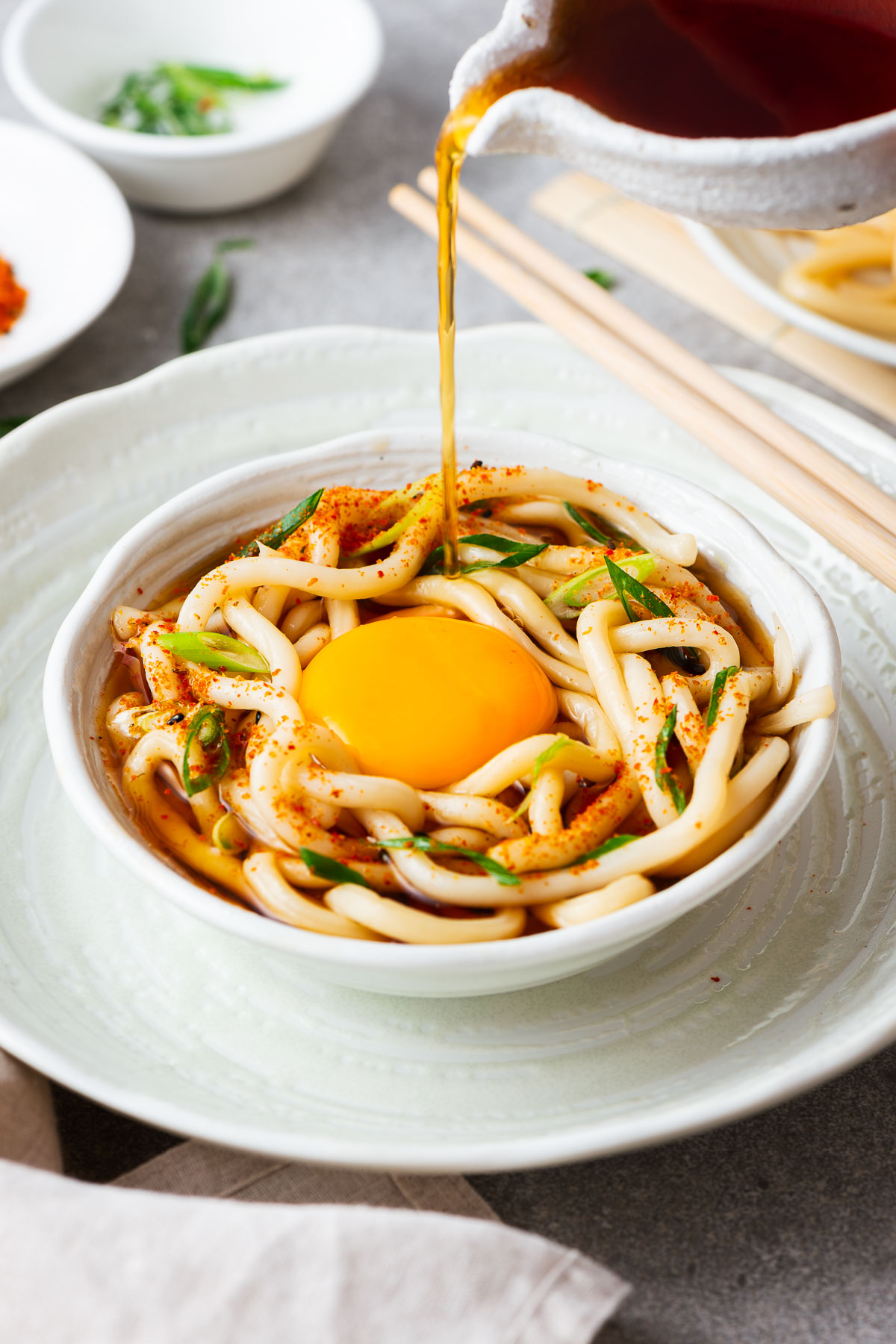
What is tsukimi udon?
Udon noodles are thick and chewy Japanese noodles made from wheat flour, water, and salt.
Tsukimi udon is a simple udon noodle soup topped with a raw egg yolk. Tsukimi means ‘moon viewing’ and refers to the raw egg yolk that looks like a shining full moon. The chewy noodles and egg yolk float in a flavourful broth made from dashi, soy sauce, mirin, and (sometimes) sake.
The dish is traditionally prepared for the mid-autumn (fall) harvest moon but it is delicious to serve at home all year round.
Tsukimi udon is similar to kake udon with the addition of the egg yolk. Another udon noodle soup, kitsune udon, is topped with seasoned fried tofu.
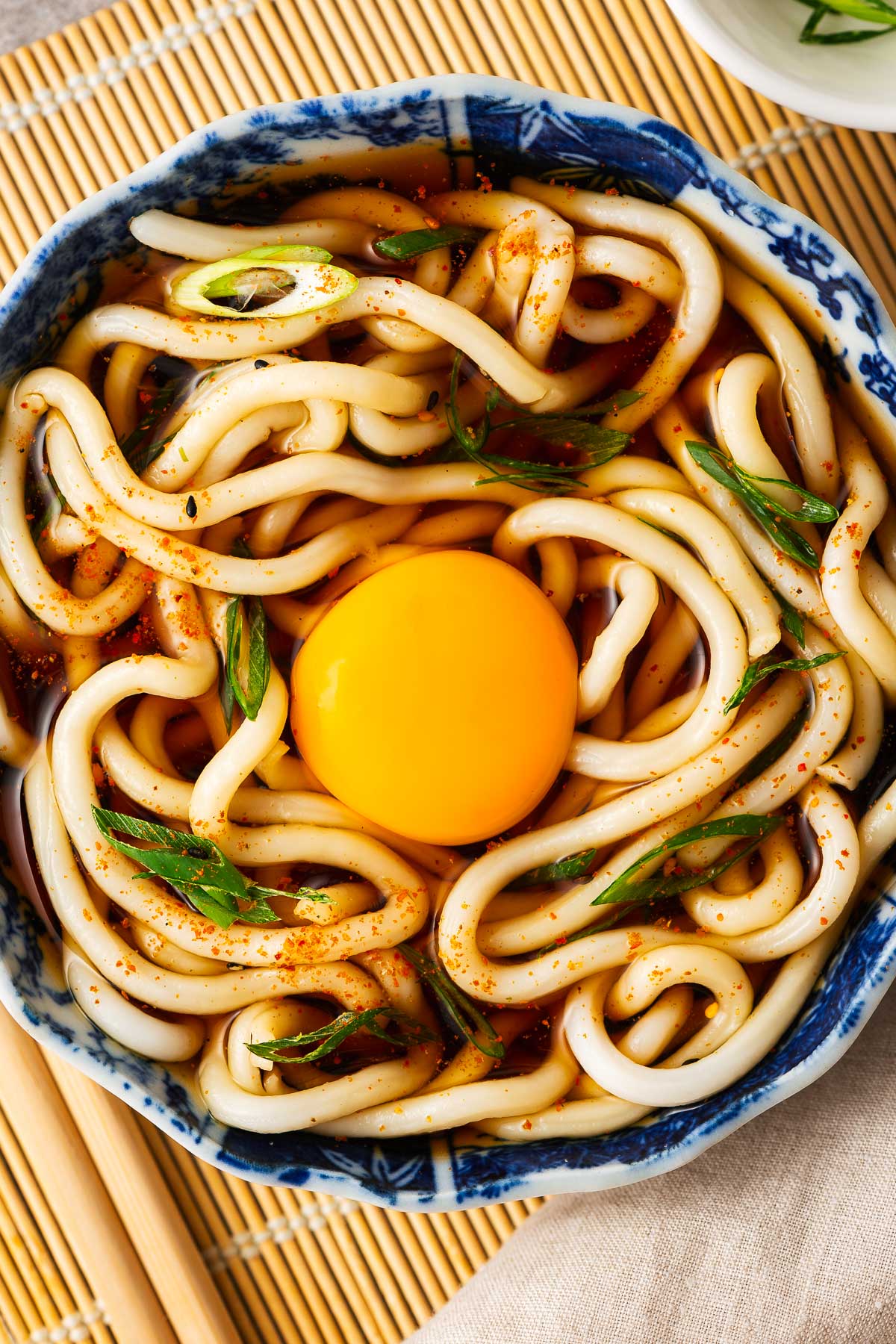
Why you’ll love this tsukimi udon recipe
Tsukimi udon is a must-try dish for any lover of Japanese cuisine:
- Super easy to make: With simple ingredients (that’s easy to substitute) and easy-to-follow instructions, this tsukimi udon recipe is perfect for busy weeknights.
- Versatile: While traditionally served with udon noodles, you can also use soba or ramen noodles for a fun twist. Plus, you can mix and match toppings to suit your preferences.
- Simple ingredients: All the ingredients for this dish, including dashi broth and udon noodles, are widely available. Find them at Asian grocery stores or even some larger supermarkets.
Ingredients and substitutes
To make tsukimi udon, you need only a handful of simple ingredients. I also suggest suitable substitutes if the ingredients are difficult to find:
- Udon noodles: Use frozen, parboiled, or fresh udon noodles for the best results. If you can only find dried udon noodles, they will work too, but won’t be as plump and chewy. You can also use soba noodles (buckwheat noodles) for a gluten-free option or even use ramen noodles in a pinch.
- Dashi broth: Dashi broth is a staple in Japanese cuisine and forms the base for many soup dishes. You can make it from scratch with kombu seaweed and bonito flakes (or dried shiitake mushrooms for a vegan dashi broth) – I use this dashi recipe from Just One Cookbook. Or use store-bought dashi or instant dashi powder. If using instant dashi powder: Follow the package instructions to mix your broth – I typically use one teaspoon of hon dashi powder for every cup of hot water.
- Soy sauce: Soy sauce adds a rich and savoury flavour. You can use light or regular soy sauce, or try tamari for a gluten-free option.
- Mirin: Mirin is a sweet rice wine that adds a subtle sweetness to the dish. I use ‘hon mirin’. If your mirin has ingredients like sugar or corn syrup, it’s not ‘real brewed mirin’ and is likely much sweeter. Go ahead and use it, but omit the sugar in from the recipe. And, if you don’t have mirin, you can use a combination of drinking sake and sugar as a substitute.
- White sugar (optional): I add a teaspoon of sugar when I use ‘hon mirin’ (true Japanese brewed mirin). If your mirin includes ingredients like corn syrup or cane sugar, you should omit the white sugar or your broth will be too sweet. Or simply adjust the sugar to taste.
- Egg yolks: The traditional topping for tsukimi udon is raw egg yolk, but you can also use a soft-boiled egg if you’re not feeling yolky.
- Scallion (green onion): Thinly sliced scallions add a fresh and aromatic flavour.
- Shichimi togarashi: This Japanese blend of seven spices adds a spicy kick to the dish. Use store-bought or homemade shichimi togarashi. Alternatively, use toasted sesame seeds and a pinch of chilli powder as a substitute.
Taste your broth and adjust the flavour with salt and sugar to taste.
You can also make the noodle broth from store-bought or homemade mentsuyu soup stock. See the kake udon recipe for instructions.
How to make tsukimi udon
Warm up with a bowl of comforting tsukimi udon – a traditional Japanese noodle soup topped with a raw egg yolk.

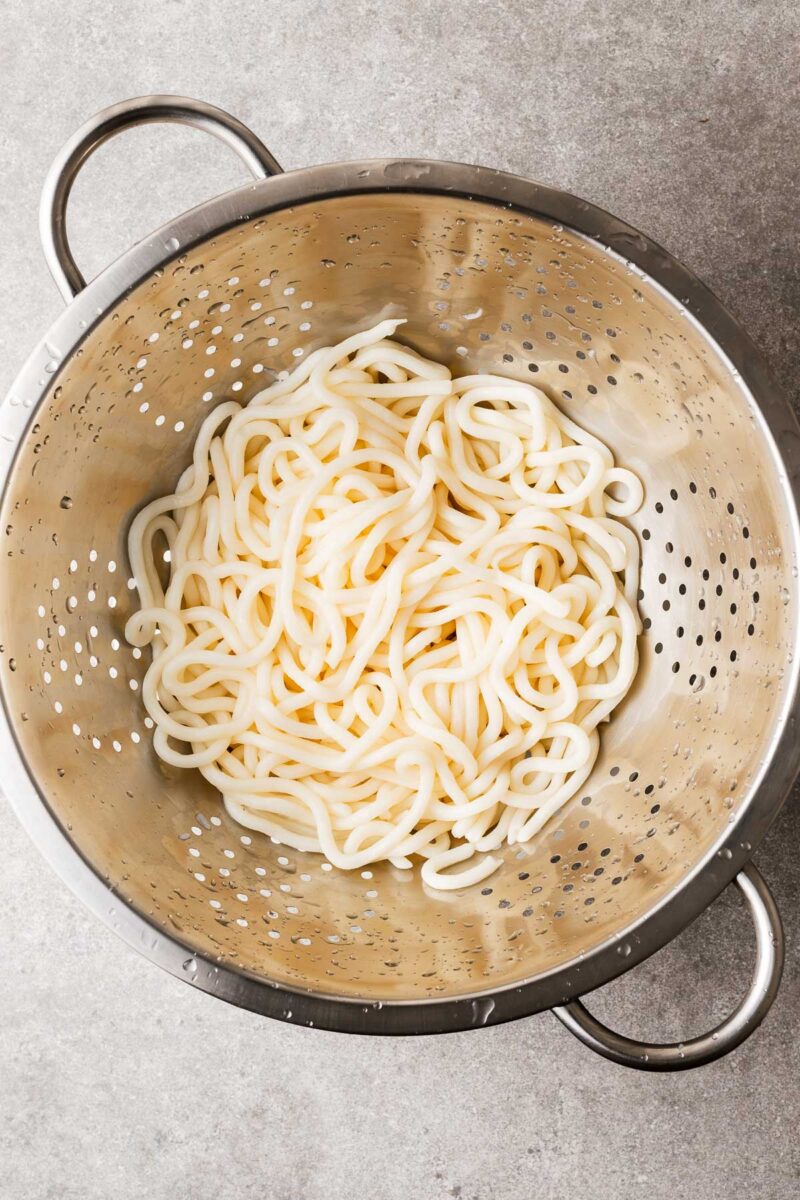
Step 1: In a large pot or saucepan, bring six cups of water to a boil. Add the udon noodles and cook according to package instructions until al dente – my parboiled noodles only need two to three minutes. Use chopsticks to stir and separate the noodles as they cook.
Step 2: Drain the cooked udon noodles in a colander and rinse with cold water.
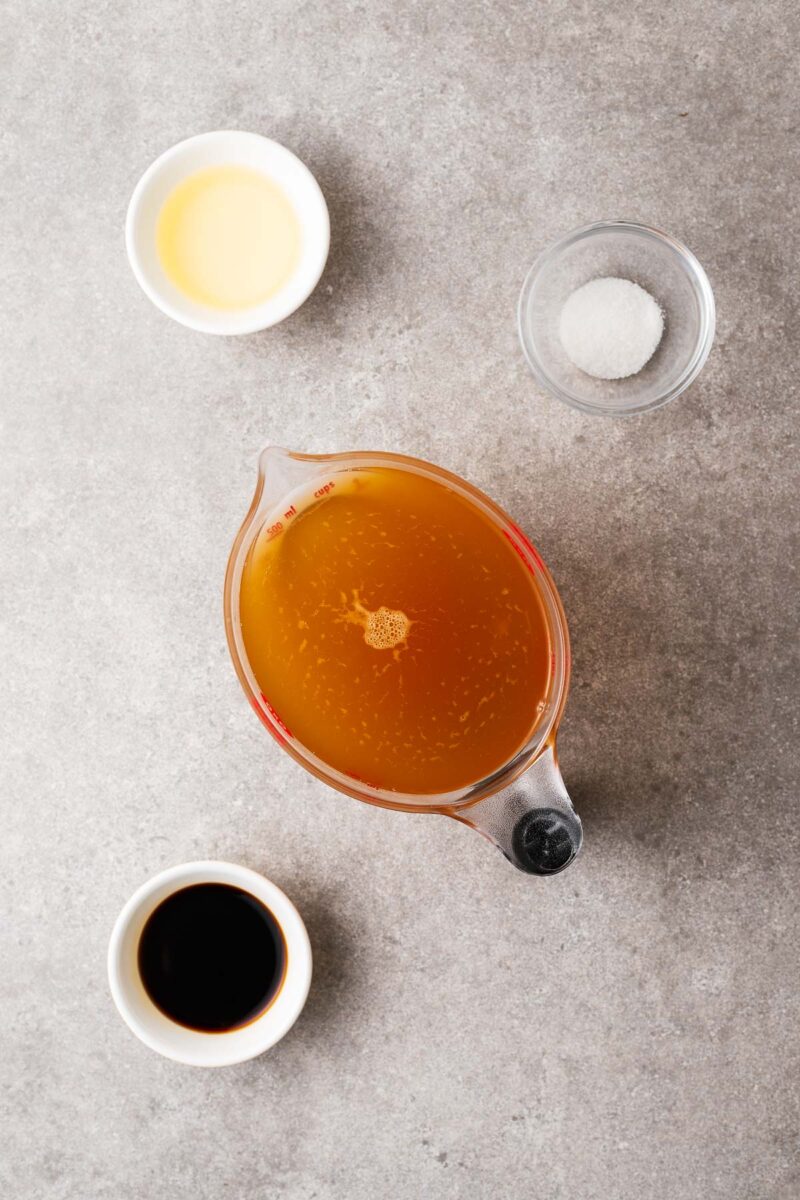

Step 3: Return the saucepan to the heat and add two and a third cups of dashi broth, two tablespoons of soy sauce, and two tablespoons of mirin. Simmer until heated through (see notes if using mentsuyu sauce). Taste first, then add the optional teaspoon of sugar, and adjust with a pinch of salt or a splash of hot water if needed.
To make the broth using homemade mentsuyu concentrate, mix half a cup of mentsuyu with two cups of water. See the kake udon recipe for more.
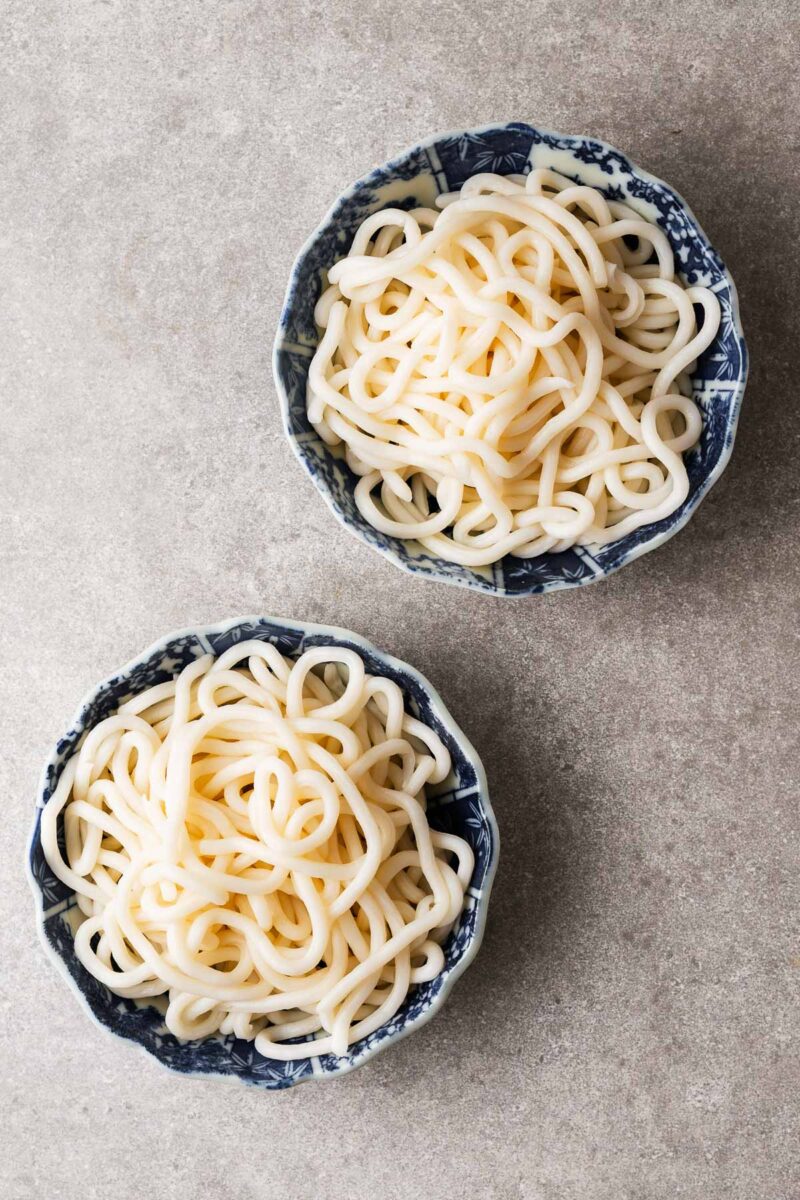

Step 4: Divide the cooked udon noodles between two serving bowls. Then pour the hot dashi broth over the noodles.
Step 5: Top each bowl with thinly sliced green onions and a raw egg yolk. Sprinkle with shichimi togarashi or sesame seeds and serve hot.
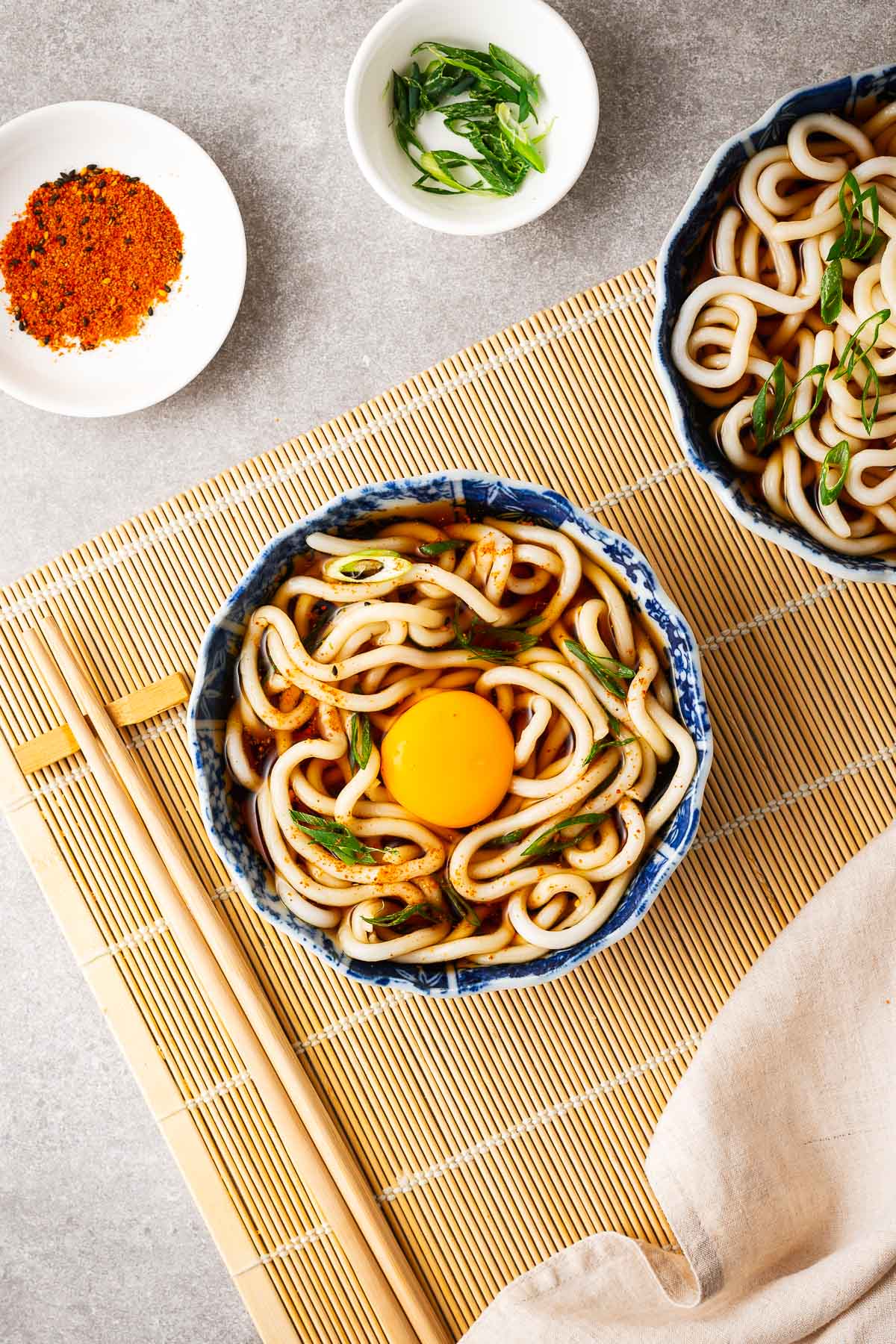
Udon noodle soup variations
I adore tsukimi udon noodle soup. The full moon surrounded by chewy noodles and a savoury broth is not just pretty, the egg yolk adds luscious texture as it heats up and thickens the broth.
But if you’re not into raw egg yolks, try a soft-boiled egg or ramen egg instead. Or opt for another Japanese udon noodle soup variation using the same delicious broth and chewy udon noodles.
- Kake udon: A simple Japanese udon noodle soup of udon noodles, a flavourful broth and sliced green onions. This kake udon recipe uses homemade mentsuyu concentrate for the easiest udon noodle broth.
- Kitsune udon: Top the kake udon with seasoned fried tofu (inari age) and pink-swirl narutomaki fish cake.
- Tempura udon: Add a deep-fried tempura shrimp and a slice of Naruto fish cake to each bowl.
- Niku udon: Add thinly sliced stir-fried beef and sliced narutomaki (fish cakes).
Don’t be limited by these suggestions, customise your comforting bowl of udon noodle soup with different toppings. And let me know in the comments what your new favourites are!
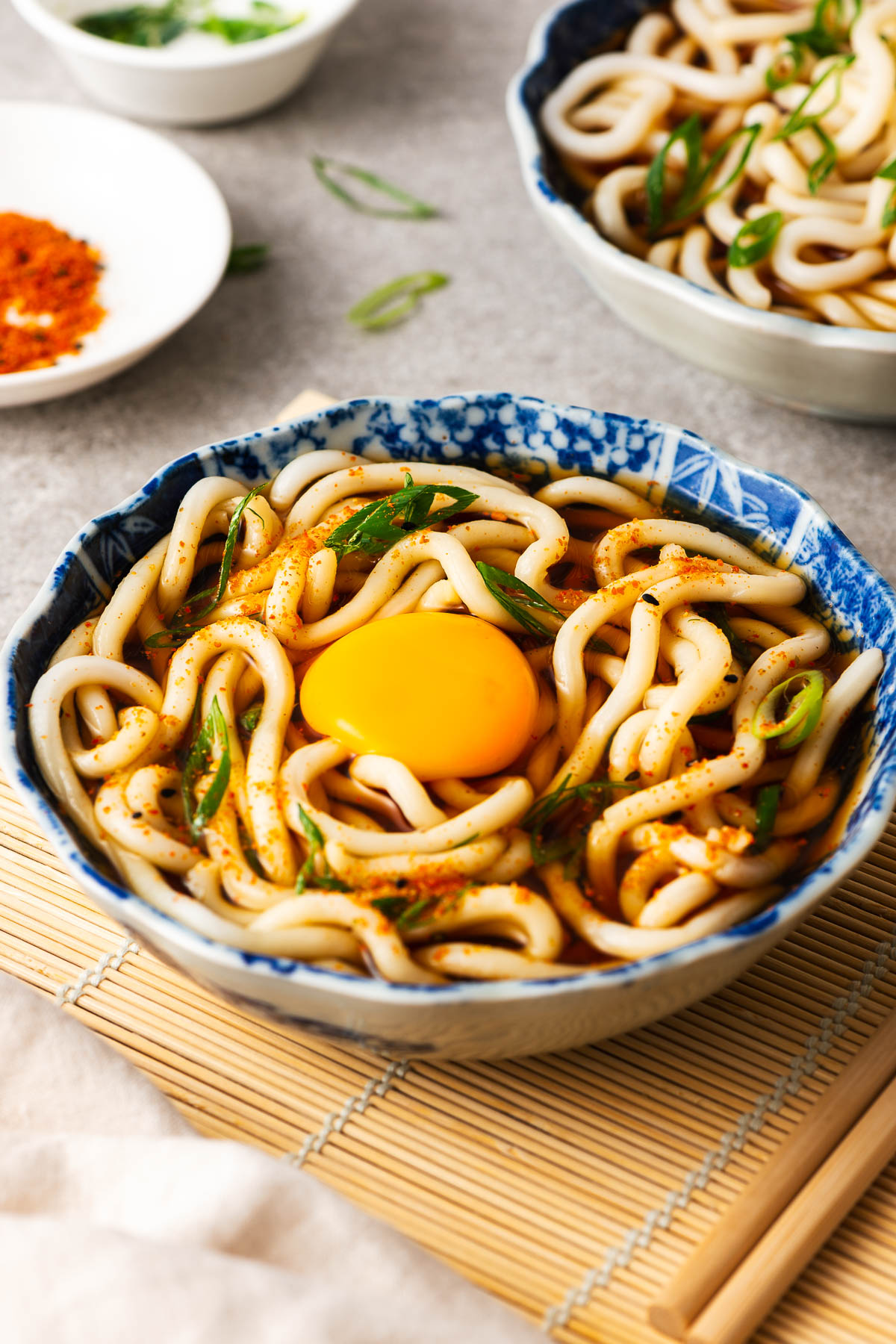
Frequently asked questions
Tsukimi udon is a Japanese noodle dish that literally translates to “moon viewing udon”. This name comes from the raw egg yolk on top of the noodles, resembling a full moon. It is a popular dish during the mid-autumn harvest moon festival in Japan of the same name.
Tsukimi udon is typically served in a hot broth made from dashi (fish and seaweed stock), soy sauce, and mirin. The raw egg yolk on top is broken open with chopsticks and mixed into the broth, adding a rich and creamy texture. The noodles are then eaten with chopsticks, along with any other toppings such as green onions or toasted sesame seeds.
Kitsune udon is a type of udon noodle dish topped with seasoned deep-fried tofu (aburaage). The broth is typically made from dashi, soy sauce, and mirin. Other common toppings for kitsune udon include green onions, tempura, and kamaboko (fish cake).
More Japanese Recipes
- Zaru soba (cold soba noodles with dipping sauce)
- Nasu dengaku (miso glazed eggplant)
- Miso scrambled eggs
- Mentsuyu sauce (Japanese soup base for quick & easy noodle soup)
- Kake udon (simple Japanese udon noodle soup)
- Tsukimi udon (Japanese moon viewing noodle soup)

Ingredients
- 2 servings udon noodles*
Dashi noodle broth*
- 2⅓ cups dashi broth*
- 2 tablespoons soy sauce
- 2 tablespoons mirin*
- 1 teaspoon sugar (optional)
- salt (optional)
Toppings
- 2 egg yolks
- 1 scallion (green onion) , thinly sliced
- pinch shichimi togarashi (Japanese 7 spice), or toasted sesame seeds
Instructions
- In a medium saucepan, bring plenty of water to a boil – at least 6 cups. Add the udon noodles and cook according to package instructions – my parboiled noodles only need 2 to 3 minutes. Separate the noodles by stirring with chopsticks.
- Rinse the hot noodles with cold water and drain in a colander.
- Return the saucepan to the heat and bring the dashi broth, soy sauce and mirin to a simmer (see notes if you have mentsuyu sauce). Taste first, then add the teaspoon of sugar (if needed). Add a pinch of salt for seasoning or a splash of boiling water if the broth is too strong for your taste.
- Divide the udon noodles between two deep bowls and pour the hot dashi broth over the udon noodles.
- Scatter over the sliced green onions. Then, nestle an egg yolk into each bowl. Sprinkle with shichimi togarashi or sesame seeds. And serve hot.
Notes
- I use packaged parboiled udon noodles sold in 7-oz portions (200 grams). You can also use fresh or frozen udon noodles. If you can only find dried udon noodles, you can use them, but they won’t be as plump and chewy as fresh, frozen or parboiled noodles.
- You can make dashi broth from scratch using bonito flakes and kombu seaweed. But you can also use store-bought dashi or instant dashi powder (follow package instructions).
- Mentsuyu is a Japanese soup base, and my homemade mentsuyu sauce recipe is concentrated and flavourful. It keeps for 4 weeks in the fridge, so it’s worth making a large batch. To use mentsuyu for a quick broth: Dilute ½ cup of homemade mentsuyu with 2 cups of water and a tablespoon of mirin – a 1:4 ratio of mentsuyu to water. Taste and adjust with more water, mentsuyu, or a pinch of salt. Or follow the package instructions for store-bought mentsuyu. See the kake udon recipe for full instructions on how to use mentsuyu to make noodle broth.
- I use hon mirin for this recipe (sweet Japanese rice wine). If your mirin has ingredients like sugar or corn syrup, it’s not “real brewed mirin” and is likely much sweeter. Go ahead and use it, but omit the sugar – otherwise, your sauce will be crazy sweet. See the ingredients and substitutes for more information.
- Tsukimi udon is traditionally served with raw egg yolk, but you can opt for a soft-boiled egg if that’s not your vibe. Or try more topping variations.

What a wonderful dish. The flavors were increcible!
I’m so glad you enjoyed it!
The chewy udon noodles add a wonderful texture that perfectly complements the light, yet deeply satisfying taste of the dashi broth. Sharing this dish with friends and family, especially during moon-viewing season, makes it an unforgettable and heartwarming experience.
I couldn’t agree more, Gianne!
I also love a raw egg yolk in my noodle soup!
When you know, you know, right? Thanks for popping in!